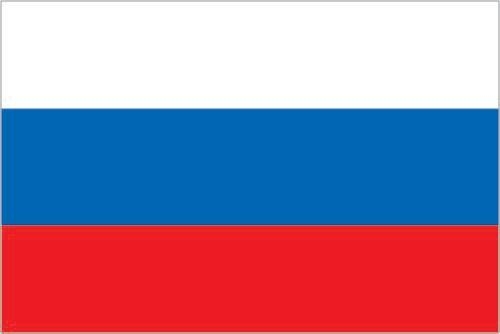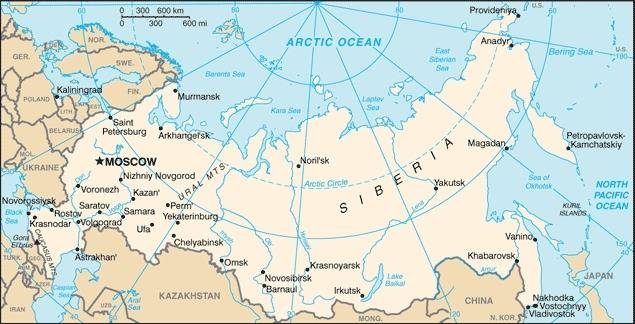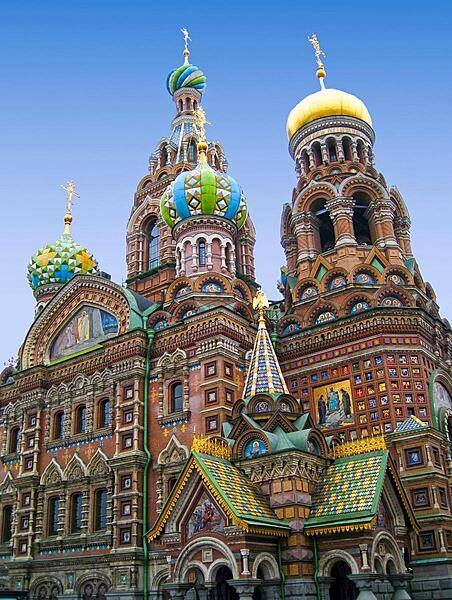105 Russian Federation

Three equal horizontal bands of white (top), blue, and red. The Russian flag was created when Russia built its first naval vessels, and was used mostly as a naval ensign until the nineteenth century. The colors may have been based on those of the Dutch flag. Despite many popular interpretations, there is no official meaning assigned to the colors of the Russian flag. The flag inspired several other Slavic countries to adopt horizontal tricolors of the same colors but in different arrangements, and so red, blue, and white became the Pan-Slav colors.
Flag courtesy of the CIA World Factbook

Map courtesy of the CIA World Factbook

The Cathedral of the Resurrection of Christ in Saint Petersburg – also known as the Church of the Savior on Spilled Blood – was built on the site of the assassination of Alexander II. Its richly decorated façade and “onion domes” resemble those of the celebrated Saint Basil’s Cathedral in Moscow.
Photo courtesy of the CIA World Factbook
Government
According to Britannica, during the Soviet era the Russian Soviet Federated Socialist Republic (the R.S.F.S.R.) was subject to a series of Soviet constitutions (1918, 1924, 1936, 1977), under which it nominally was a sovereign socialist state within (after 1936) a federal structure. Until the late 1980s, however, the government was dominated at all levels by the Communist Party of the Soviet Union, which was all-powerful and whose head was the country’s de facto leader. Indeed, in the elections that were held, there was only a single slate of candidates, the great majority of whom were in effect chosen by the Communist Party.
From the late 1980s through 1991, the period of Mikhail Gorbachev’s perestroika (“restructuring”), glasnost (“openness”), and demokratizatsiya (“democratization”) reform policies, fundamental changes took place in the political system and government structures of the Soviet Union that altered both the nature of the Soviet federal state and the status and powers of the individual republics. In 1988 the Soviet Congress of People’s Deputies was created, and a Congress of People’s Deputies was established in each republic. For the first time, elections to these bodies presented voters with a choice of candidates, including non communists, though the Communist Party continued to dominate the system.
Thereafter, the pace of change accelerated. In June 1990 the Congress of the Russian republic proclaimed that Russian laws took precedence over Soviet laws, and the following year Boris Yeltsin became the republic’s first democratically elected president. An abortive coup in August 1991 by hard-liners opposed to Gorbachev’s reforms led to the collapse of most Soviet government organizations, the abolition of the Communist Party’s leading role in government, and the dissolution of the party itself. Republic after republic declared its “sovereignty,” and in December, when the Soviet Union was formally dissolved, Russia was established as an independent country.
The structure of the new Russian government differed significantly from that of the former Soviet republic. It was characterized by a power struggle between the executive and legislative branches, primarily over issues of constitutional authority and the pace and direction of democratic and economic reform. Conflicts came to a head in September 1993 when President Yeltsin dissolved the Russian parliament (the Congress of People’s Deputies and the Supreme Soviet); some deputies and their allies revolted and were suppressed only through military intervention.
On December 12, 1993, three-fifths of Russian voters ratified a new constitution proposed by Yeltsin, and representatives were elected to a new legislature. Under the new constitution the president, who is elected in a national vote, is vested with significant powers. As Russia’s head of state, the president is empowered to appoint the chairman of the government (prime minister), key judges, and cabinet members. The president is also commander in chief of the armed forces and can declare martial law or a state of emergency. When the legislature fails to pass the president’s legislative initiatives, he may issue decrees that have the force of law. In 2008 an amendment to the constitution, which took effect with the 2012 election, extended the presidential term from four to six years. Prior to 2020 the president could not serve more than two consecutive terms, but constitutional changes enacted that year abolished term limits for the office.
Under the new constitution the Federal Assembly became the country’s legislature. It consists of the Federation Council (an upper house comprising appointed representatives from each of Russia’s administrative divisions) and the State Duma (a 450-member popularly elected lower house). The president’s nominee for chairman of the government is subject to approval by the State Duma; if it rejects a nominee three times or passes a vote of no confidence twice in three months, the president may dissolve the State Duma and call for new elections. All legislation must first pass the State Duma before being considered by the Federation Council. A presidential veto of a bill can be overridden by the legislature with a two-thirds majority, or a bill may be altered to incorporate presidential reservations and pass with a majority vote. With a two-thirds majority (and approval by the Russian Constitutional Court), the legislature may remove the president from office for treason or other serious criminal offenses. The Federation Council must approve all presidential appointments to the country’s highest judicial bodies (Supreme Court and Constitutional Court).
The constitution provides for welfare protection, access to social security, pensions, free health care, and affordable housing; it also guarantees local self-governance. Nevertheless, national law takes precedence over regional and local laws, and the constitution enumerates many areas that either are administered jointly by the regions and the central government or are the exclusive preserve of the central government. In the years after the constitution’s enactment, the central government implemented several measures to reduce the power and influence of regional governments and governors. In 2000 Pres. Vladimir Putin created seven federal districts above the regional level to increase the central government’s power over the regions (see discussion below). His successor, Dmitry Medvedev, continued this policy: as a part of Moscow’s ongoing efforts to quell separatism and Islamic militancy in the Caucasus, he created an eighth federal district there in 2010.
Under the Russian constitution the central government retains significant authority, but regional and local governments have been given an array of powers. For example, they exercise authority over municipal property and policing, and they can impose regional taxes. Owing to a lack of assertiveness by the central government, Russia’s administrative divisions, oblasti (regions), minority republics, okruga (autonomous districts), kraya (territories), federal cities (Moscow and St. Petersburg), and the one autonomous oblast—exerted considerable power in the initial years after the passage of the 1993 constitution. The constitution gives equal power to each of the country’s administrative divisions in the Federal Assembly. However, the power of the divisions was diluted in 2000 when seven federal districts (Central, Far East, Northwest, Siberia, Southern, Urals, and Volga), each with its own presidential envoy, were established by the central government. In 2010 the southeastern portion of the Southern district was reorganized as an eighth federal district, North Caucasus. Russia’s ninth federal district was created in 2014, after it annexed the Ukrainian autonomous republic of Crimea; this territorial claim was not recognized by Ukraine or most other countries, but Russia exercised de facto control of the region. The districts’ presidential envoys were given the power to implement federal law and to coordinate communication between the president and the regional governors. Legally, the envoys in federal districts had solely the power of communicating the executive guidance of the federal president. In practice, however, the guidance served more as a directive, as the president was able to use the envoys to enforce presidential authority over the regional governments.
In comparison to the federal government, regional governments generally have inadequate tax revenue to support mandatory items in their budgets, which have barely been able to cover wages for teachers and police. The budgets of regional governments also are overburdened by pensions.
Legislation has further affirmed the power of the federal government over the regions. For example, the regional governors and their deputies were prohibited from representing their region in the Federation Council on the grounds that their sitting in the Federation Council violated the principle of the separation of powers; however, under a compromise, both the legislative and executive branch of each region sent a member to the Federation Council. Legislation enacted in 2004 permitted the president to appoint the regional governors, who earlier were elected. In the first decade of the 21st century, the country began to undergo administrative change aimed at subordinating smaller okruga to neighboring members of the federation.
Following these reforms in regional government, the new federal districts began to replace the 11 traditional economic regions, particularly for statistical purposes. The Central district unites the city of Moscow with all administrative divisions within the Central and Central Black Earth economic regions. The Northwest district combines the city of St. Petersburg with all areas in the North and Northwest regions, including Kaliningrad oblast. The Southern district includes portions of the Volga and North Caucasus economic regions; the North Caucasus district encompasses the remaining units of the latter economic region. The Volga district merges units of the Volga, Volga-Vyatka, and Ural economic regions. The Urals district consists of the remaining administrative divisions of the Ural economic region along with several from the West Siberia economic region. The Siberia district unites the remainder of the West Siberia economic region and all of East Siberia. Finally, the Far East district is congruent with the Far East economic region. The Crimean district, created in 2014 following Russia’s annexation of Ukrainian territory, included the federal city of Sevastopol.
Several of the administrative divisions established constitutions that devolved power to local jurisdictions, and, though the 1993 constitution guaranteed local self-governance, the powers of local governments vary considerably. Some local authorities, particularly in urban centers, exercise significant power and are responsible for taxation and the licensing of businesses. Moscow and St. Petersburg have particularly strong local governments, with both possessing a tax base and government structure that dwarf the country’s other regions. Local councils in smaller communities are commonly rubber-stamp agencies, accountable to the city administrator, who is appointed by the regional governor. In the mid-1990s municipal government was restructured. City councils (dumas), city mayors, and city administrators replaced former city soviets.
Russia’s highest judicial body is the Supreme Court, which supervises the activities of all other judicial bodies and serves as the final court of appeal. The Supreme Court has been supplemented since 1991 by a Constitutional Court, established to review Russian laws and treaties. The Constitutional Court is presided over by 19 judges, who are nominated by the president and approved by the Federation Council. Appointed to life terms, judges for both the Supreme Court and the Constitutional Court must be at least 25 years of age and hold a law degree. The Constitutional Court has the power of judicial review, which enables it to rule on the constitutionality of laws. The Russian legal system has attempted to overcome the repression practiced during the Soviet era by requiring public trials and guaranteeing a defense for the accused. Historically, the Supreme Arbitration Court of the Russian Federation had ruled on commercial disputes, but it was abolished in 2014, and its powers were absorbed by the Supreme Court.
Federal Agency for Air Transport (Rosaviatsiya)
The Federal Agency for Air Transport (Rosaviatsiya) is a federal executive body that provides government support in managing state-owned property in the air transport industry (civil aviation), controlling the airspace of the Russian Federation, air navigation services within Russian airspace; aeronautical search and rescue; air transport security and the government certification of aircraft ownership rights and related transactions.
Airspace
SkyVector – Google Maps – ADS-B Exchange
ICAO countries publish an Aeronautical Information Publication (AIP). This document is divided into three parts: General (GEN), En Route (ENR) and Aerodromes (AD). ENR 1.4 details the types of airspace classes they chose to adopt from classes A through G.
Drone Regulations
Federal Law No. 462-FZ of December 30, 2015 “On Amending the Air Code of the Russian Federation with regard to the use of unmanned aircraft”
Decree of the Government of the Russian Federation No. 658 , which established the rules for registering drones. In accordance with it, from September 27, 2019, drones must be registered with the Federal Air Transport Agency.
Government Decree No. 74 dated February 03, 2020 “On Amendments to the Federal Rules for the Use of the Airspace of the Russian Federation”.
Government Decree No. 415 dated March 19, 2022, according to which the minimum threshold for registering a quadrocopter was reduced from 250 g to 150 g.
Application for free registration, re-registration, deregistration of a quadrocopter submitted through Portal “Gosuslugi”
Accounting portal for unmanned aerial vehicles of the Federal Air Transport Agency
For flights in St. Petersburg, Sevastopol and Moscow, you must obtain permission from the regional executive authority. In the case of Moscow, this is the Department of Regional Security and Anti-Corruption
Maps of restricted and control zones:
- Service “Flight plans” ;
- PilotHub;
- Google Earth when using special layers;
- A list of restricted areas is available in the Consultant Plus catalog. But you can get acquainted with it for free only during non-working hours.
Advanced Air Mobility (AAM) Regulations & Policies
Bilateral agreements facilitate the reciprocal airworthiness certification of civil aeronautical products imported/exported between two signatory countries. A Bilateral Airworthiness Agreement (BAA) or Bilateral Aviation Safety Agreement (BASA) with Implementation Procedures for Airworthiness (IPA) provides for airworthiness technical cooperation between the FAA and its counterpart civil aviation authorities.
Bilateral Aviation Safety Agreement – Executive Agreement
Implementation Procedures for Airworthiness
Revised Export Documentation Requirement For Engines And Propellers
2016 Notification of Policy Deviation Memorandum for FAA Order 8130.21H
Letter to Industry – Russian Federation Organizational Change
Revised – CAA Responsibilities for Russia and Members of the Commonwealth of Independent States
Obtaining Certification Approval from this Country
Advanced Air Mobility (AAM) News
None found by the author.
However, should you, the reader, happen to stumble across something to the contrary, please email the author at FISHE5CA@erau.edu and you may be mentioned in the ACKNOWLEDGEMENTS section of this book by way of thanks for contributing to this free eBook!
Short Essay Questions
Scenario-Based Question
You have been hired by a Drone Startup Company. Your boss has immediately assigned this job to you.
They need you to prepare a one-page memo detailing the legalities of using a drone to film in Saint Petersburg, pictured above.
They need you to mention any national laws and local ordinances.
They specifically want to know what airspace (insert pictures) you will be operating in and whether or not you need an airspace authorization.
Does it matter whether or not you are a citizen of the country?
Lastly, there is a bonus for you if, as you scroll through this chapter, you find any typos or broken links!
Short Essay Questions
- What are the drone categories?
- How is registration addressed?
- How is remote ID addressed?
- What are the model aircraft rules?
- What are the commercial drone rules?
- Are there waivers or exemptions to the rules? If so, for what?
- Would you share a link to an interactive airspace map?
- How is BVLOS addressed?
- How can you fly drones at night?
- How can you fly drones over people?
- Where do you find drone NOTAMs?
- What are the rules for drone maintenance?
- What are the rules for an SMS program?
- What are some unique rules not mentioned above?
- What are the C-UAS rules?
- What are the AAM rules?

